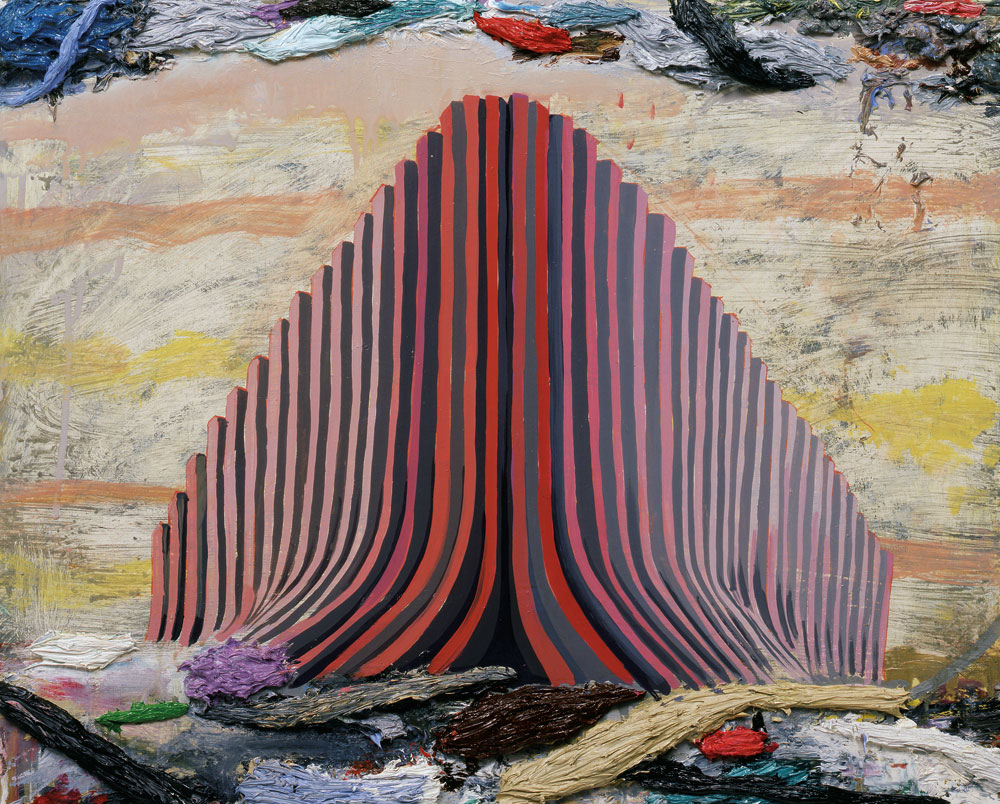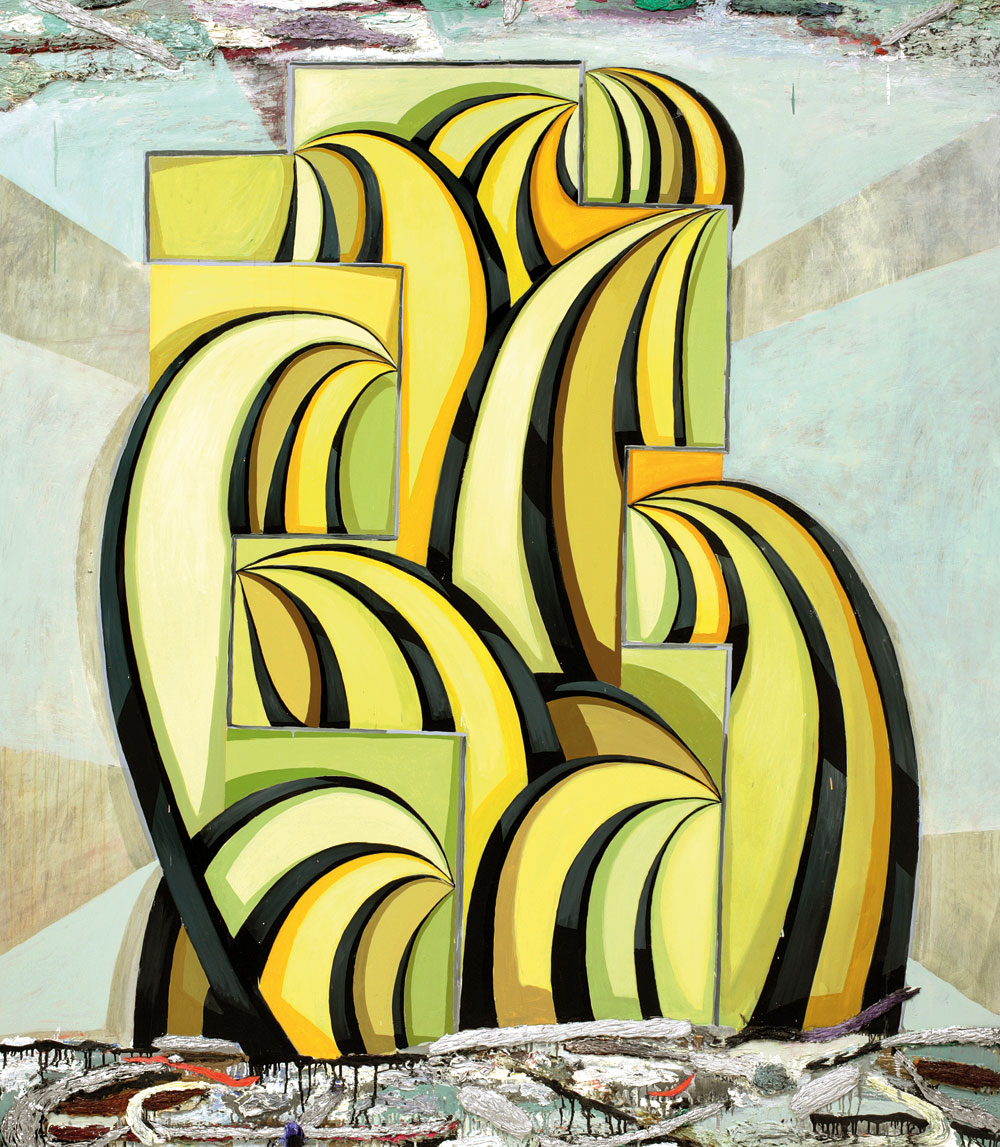Mind's Eye
The animism and imagination of Phillip Allen’s painterly abstractions
The animism and imagination of Phillip Allen’s painterly abstractions

What if his house was on fire? He’d save his drawings. What if someone admired his art and invited him to make a book? Phillip Allen – Drawings, a festival of felt-tip sketches, was published by Other Criteria in 2007. Drawing, the activity at the core of the London-based painter’s work, equals potential. Open that book somewhere near the middle and locate a monstrous, fluted architectural form, a giant pipe organ spliced with a windowless church: it will reappear, a little more streamlined and pinkish, a little more like a three-dimensional spectrogram but still obscurely grand and fearful, a year later in the oil-on-board Volume Champion (2008). On other pages a dark, rearing cyclonic form appears, composed of interlocking club-like shapes resembling Philip Guston boots or kicked-over P’s. (Since 2001’s 33 Allen has sporadically made paintings featuring his own current age; you wouldn’t put forename-initialising past him.) We’ll see that motif again, more complexly essayed and with airborne golden echoes of the central form flanking it, in the painting Postopia (2008).
The blank canvas scares him, he says. Even with a rumpled drawing as insurance – assuring that he’ll have something to paint – Allen starts by bullying the surface into a peremptory spatiality, into life. Before any imagery goes down, he applies horizontal bands of varicoloured, rosette-whorled or linearly extruded impasto, a sort of gnarly and lustrous Cinemascope letterboxing which pops forth far enough that anything else placed in the central area is already oriented in space, behind the bands, over which the eye has to hurdle. Then, centralised on the dirty, hazy ground he applies next, floating forms and fantastical arches and sundry non-Euclidean phenomena appear in something like a landscape. Superficially this is a pragmatic process of making, a sort of systemised mastering of a forbidding dead rectangle. Fine, except that along the ritualised way, something – a painterly hologram of place, protean and weird, contradictory and intermittently epic – springs into strangely plausible life. Does the art live there, though, in illusion-building? Not really. Not so much as it does in the gulf between chimera and procedure.

Let’s play word association: Lovejoyvian. What are you thinking? (Aside from ‘that’s not a word’; play along, please.) Of the mullet-sporting, forename-lacking fictional antiques dealer, Lovejoy, who first graced BBC television’s schedules in the 1980s? Of HP Lovecraft, perhaps, whose stories ensure that anyone attempting psychological horror-laced sci-fi set in peculiar, animist realms will be branded Lovecraftian? Now let’s play image association, using Allen’s painting Lovejoyvian (Extended Version) (2008). We are back in Allenland, naturally, where singular scale-less entities habitually loom up against gristly backgrounds equating to sky. Today’s freak event is a sucking vortex that splits the very air into discrete radials and disconnected segments, as if the atmosphere and its contents had been sliced up and unthinkably reassembled; the airspace is dense with coloured circles severed into hemispheres, receding into the whirl’s eye. What’s interesting (not least because Allen says he doesn’t read Lovecraft, being more of a Stanislaw Lem man) is that even without the title, this storm of dissolving decorative abstraction brings weird animism, antiquation and a comic dash of the aesthetically unfashionable directly to mind.
Allen does like his perky semicircles. His turbid 2003 series of paintings entitled ‘Beezerspline’ (with various ‘… version’-suffixed subtitles, as if the artist, an aficionado of dub, were remixing his work) were full of them, strung into spindly bulbous arches in distant quarters of Allenland. These sociable split circlets add some outward cheer to the paintings, or rather the graphic brightness precisely counterbalances the landscapes’ inhuman mood, leaving them irreducibly compounded: happy/sad, friendly/threatening. Other manifestations in other paintings, particularly those made in the last five years, less resemble fixed objects than energetic fields: the spilling cloud of pastel-coloured kite shapes that floods Interzonal Level Sequence (this is just a test version) (2006), the floating speech balloons in black, blues and tan of Second Ace Worry (international version) (2004). The latter shapes seem lifted from 1950s graphic design, and a fair amount of Allen’s production elsewhere takes what ought to be two-dimensional forms, often loosely reflective of 20th-century abstraction and its extension into applied art, and agglutinates them into freestanding solidities or at least embeds them in implied depth. Connectedly, here are some more titles: Intentionally Clumsy; Little Moments of Small Joy; Sloppy Cuts No Ice; Rich History of Foul Ups; Pinnacle Mind Hell; Postopia; The Falestorm. Things have gone wrong, such appendages might imply, albeit possibly the collapse has its own consolations; and we are here, after the end. Is Allenland a purgatory of sorts for the syntactical elements of modernism, a place where these forms and gestures, deathless but not lively, nevertheless retain the residual energy to combine themselves into monuments to their own obsolescence? Is Allen, in short, one of those artists, a glib attendant at the wake?

Bear in mind that one thing a viewer will find while traversing these rutted plains is monuments to Allen himself, to his own age. Another trend, similarly taking the form of gilded but stranded monuments, is for stacks of three-dimensional letters: WXY (2008), for instance. Again the sense of an ending inheres, but the letters are arranged to create the schematic shape of a female figure (there’s also a male version from the same year, OMN), an optical trick Allen learned in the pub; it’s a body if you want it to be. And, while we’re considering what or whom might be at the heart of this work, one more title: ‘Pareidolia’, for a series of recent collages in which, on small sheets of board, messy grids of Allen’s signature paint-whorls serve as frames for central images – bearded commissioners toting flowers, moon-walking astronauts, smiling nude figures from National Geographic. What do these subjects have to do with the extrusive, gaudy abstraction that blooms around them? What do they have to do with each other?
Nothing either good or bad, to quote the Bard, but thinking makes it so. Pareidolia, for those that don’t know, is the psychological phenomenon of seeing sense and pattern where it isn’t: familiar shapes in drifting cumuli, Christ’s face in burnt toast, etc. Blatantly a facet of Allen’s collages, it’s also a concept applicable to his paintings. Take Tedious Plan (Studio Version) (2004), in which a spidery, symmetrical structure of angled lines rises out of the ground, each one topped with a gaily coloured ball, like a Charles and Ray Eames ‘Hang It All’ coat rack with pretensions to architecture. Like many of Allen’s structures – for example, the triangular figure composed of alternating floating balls and ensigns in Pinnacle Mind Hell (2008) – it seems to strike upward and recede in space simultaneously. You imagine coming across it in this wasteland, a convivial but alien presence. And then perhaps you snap back, because what is this image, really? It’s a confection of hooks: an illusory space to wade into; a smattering of bright colour and apprehensible form; a frisson of painterly angst; the lure of the fantastical. Tedious Plan, you may discern, threatens to comprise nothing more than a conflation of shrewd strategies to make you look, the place you build out of it and the life with which you endow it owing mostly to the firing of your own neurons. That somewhat deflating implication (associable with the suggestions of failure or shortfall which drift through some of his titles) glimmers within Allen’s art in the moments when you’re not fantasising: when you turn suspicious, recognising it as a succession of projective screens, repudiating it. Someone is pulling strings here, and it’s the guy who keeps leaving shiny monuments to his own age around the place.

This might be enough as an admission of the throat-clearing and disclaiming necessary to make a painting now, in good conscience, without false hope; but it’d be a cold take on the medium’s residual potentialities and, perhaps, its deeper, shiftier role as a locus for desire. The reading short-changes Allen’s art, which simultaneously partakes of a minor tradition of dreamy painterly strangeness: the eerie-objects-in-landscape continuum of paintings like Paul Nash’s 1935 Equivalents for the Megaliths. It is rooted, again, in the perpetual surprise that comes from semi-automatic drawing and discovering, accordingly, what lurks in the storehouse of the mind. And it figures painting, with however much circumspection, as a site of passage, a threshold space. Bear in mind that, when it isn’t oriented around mysterious forms bursting out of inert ground, Allen’s iconography tends to revolve around traversable open arches, stairways, gates, permeable fields. These are paintings that want to figure a way through to something, are blighted by doubts that they can get you there, yet continue to make the attempt. The feel is resultantly conflicted, perpetually irresolute, suspended.
There is an Allen painting from 2005, one of a series, that depicts a fizzing electrified miasma of split black dots and outwardly shooting vectors or ramps. He has titled it Katterfelto (early promise version), presumably after Gustavus Katterfelto, the quack doctor who amazed and conned Georgian Britain with conjuring tricks, experiments and unequivocal deceits (he offered a cure for influenza during the epidemic of 1782 and claimed to have invented perpetual motion). Yet the painting proffers a seductively perilous space that insinuates itself as adeptly as any of the maker’s others, and we’re drawn steadily towards it; and towards vexation, too. Do we want our Katterfeltos exposed before they begin, Allen asks, or do we want to live through those briefly enlarging moments as members of their audience, cradled in illusion, in the trick’s phase of early promise? The wonder and the tragedy may be this: really, we want both.























